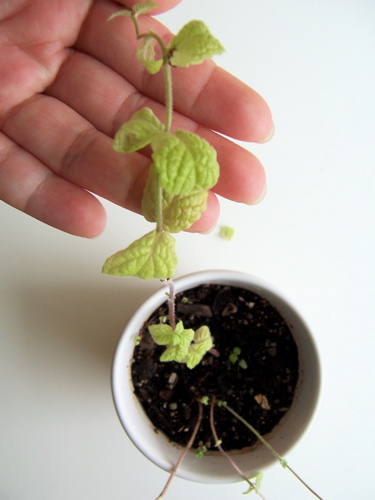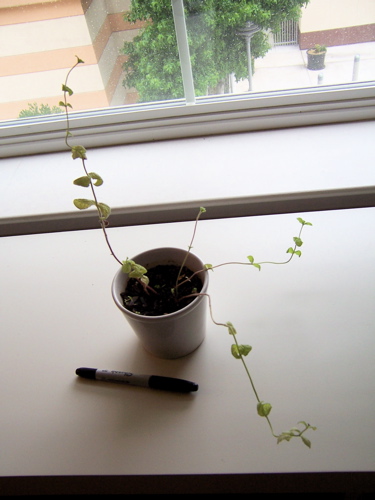
It was a quiet Friday night at home last night because I had been struck by a bad attack of allergies. A perfect night to ply those yarn
singles that I had finished before Moocow came to visit. (Moocow has the pictures from her visit, so I am waiting for her to send them to me, or post some herself).
I don't have a lot of fancy spinning equipment. Just my drop spindle and my hands. I did want to make a 2-ply yarn, though. (That is, a yarn made by spinning two singles together.) Without another drop spindle, bobbins, a
lazy kate, or even a
ball winder, I decided that my best option was to experiment with the Andean Plying technique.
What does the Andean Plying technique do? Well, it is a method of winding yarn singles off of a single spindle - and onto your hand - in such a way as to produce a centre-pull "bracelet" of yarn, from which you can pull
both ends of yarn at once, without creating a tangled mess. That means that you can make a 2-ply yarn from just one ball of yarn, instead of working off of two spindles, two bobbins, or two separately wound balls of singles.
I decided to follow the winding-off technique on Mielke Fibers'
page, because they had decent diagrams. Then, off I went, winding away. It looks complicated to begin with, but soon I watched in amazement (then, in mounting concern) as more yards of yarn singles than I had imagined began to accumulate on my left hand. I quickly came to understand why others have written that their middle finger begins to turn blue.
 I also learned a couple of other important lessons:
I also learned a couple of other important lessons:
- Before you start Andean Plying, eat and drink something, go to the bathroom, turn on your answering machine, and make sure nothing is on the stove. Once you start, you have to finish!
- When the instructions say to keep track of the ends, they mean it! Don't lose that loose end that you started with amidst your growing ball of yarn. Believe me. I learned this the painful way; I had to rewind my bracelet because I couldn't find my other end! (See how super-neat my ball of yarn is, with just a single loose end? That isn't the goal for Andean Plying.)
- I like my middle finger, and don't want to lose it. Don't try to remove the yarn by manipulating your finger. Ouch! You slip the ball of yarn off your hand as you would a boxing glove. Then, you slip the resulting bracelet around your wrist.
- Do not overload your drop spindle with singles. You fingers (mainly, your middle finger) is only so long. You may run out of room on your hand if you have too much yarn to wind on.
- I want a Handy Andy, to save me further pain and frustration.
If you think about it, whoever invented the Andean Plying technique was a genius. A sadistic/masochistic genius, but a genius all the same. Trust the instructions, follow the directions, and it really works!

So, having had the opportunity to practice my winding technique
twice, with the bracelet of yarn on my left wrist and the two ends of singles firmly in hand, I proceeded to spin/ply them onto my drop spindle. I was surprised by the change in texture that the plying produced. Whereas the singles were fairly solid, firm threads (probably overspun by yours truly), the plied yarn was softer and fluffier.

Since I didn't have a
skeinwinder/yarn swift or a
niddy noddy, I wound my plied yarn off of the drop spindle and onto the back of a chair.

Then, I tied four sections around the skein with figure-8 ties, to keep the skein tangle-free.

Here's a close-up of the figure-8 tie (and the yarn!).

Then, I soaked the tied off skein in some Eucalan, a lavender scented wool wash with lanolin.

Soaking the plied yarn relaxes the yarn and evens out any extra twist from over-spinning, so that the finished yarn is balanced, bouncy, and ready for knitting.

Squeeze (don't twist! or rub!) the water out of your skein of yarn and press it in some towels to remove most of the moisture.

Then, hang the skein up and hang a small weighted object at the bottom of the loop to balance that twist. I just hung another clothes hanger on the bottom, weighted with a little pouch with things inside it.

That skein of yarn is still drying, but I will have pictures of the finished yarn soon. Now that I have gone through the entire process once, I feel ready to spin the wine red corriedale that Moocow chose,
way back when, for me to spin so that she could knit a pair of Elizabeth Zimmermann mittens.

 I was looking over old photos I'd taken of a food class I took in Italy and came across a series of bodacious tomato shots taken at a market in Bologna.
I was looking over old photos I'd taken of a food class I took in Italy and came across a series of bodacious tomato shots taken at a market in Bologna. I can't imagine why I didn't post these pictures sooner, but here they are.
I can't imagine why I didn't post these pictures sooner, but here they are.  Looking at all that round, fleshy red make me nostalgic for the gorgeous bounty of European markets in summer.
Looking at all that round, fleshy red make me nostalgic for the gorgeous bounty of European markets in summer. 



 I departed seriously from the recipe. What follows is what I did, and not necessarily what you should do for an "authentic" recipe. Instead of beef or pork, I had a seafood mix, which I marinated with ginger juice (I grated, then squeezed, a large piece of ginger), minced garlic, sesame oil, white pepper and soy sauce.
I departed seriously from the recipe. What follows is what I did, and not necessarily what you should do for an "authentic" recipe. Instead of beef or pork, I had a seafood mix, which I marinated with ginger juice (I grated, then squeezed, a large piece of ginger), minced garlic, sesame oil, white pepper and soy sauce.
 I started out sauteing the onion and squash (I would have added the daikon at this point, but I forgot I had daikon until later in the cooking process), and adding chili powder, salt and a little bit of soy sauce. Then, I added water (you could also use beef broth) and kimchi (I added my daikon in at this point, too) and brought it to a boil. I used some of the cooking liquid to thin out a bit of the chili soybean paste, and added that back to the pot. The tofu is gently spooned in, then the seafood is added. After a couple of minutes, I stirred in some salted shrimp, chopped up hot peppers, and the scallions.
I started out sauteing the onion and squash (I would have added the daikon at this point, but I forgot I had daikon until later in the cooking process), and adding chili powder, salt and a little bit of soy sauce. Then, I added water (you could also use beef broth) and kimchi (I added my daikon in at this point, too) and brought it to a boil. I used some of the cooking liquid to thin out a bit of the chili soybean paste, and added that back to the pot. The tofu is gently spooned in, then the seafood is added. After a couple of minutes, I stirred in some salted shrimp, chopped up hot peppers, and the scallions.




 I've made
I've made  We got a lot of huge slicing tomatoes in the CSA, though, and a recipe in our newsletter for scalloped tomatoes, so I thought, "Why not?"
We got a lot of huge slicing tomatoes in the CSA, though, and a recipe in our newsletter for scalloped tomatoes, so I thought, "Why not?" I didn't quite know what to expect for this dish, but it wasn't soggy at all. The other vegetables and toast give the tomatoes some texture, and I was surprised by how good it tasted, too. It may have been the Dijon mustard that saved it all from being bland.
I didn't quite know what to expect for this dish, but it wasn't soggy at all. The other vegetables and toast give the tomatoes some texture, and I was surprised by how good it tasted, too. It may have been the Dijon mustard that saved it all from being bland.



 The instructions had said simply to prick the crust and bake it. I should have followed my instincts to line the crust with parchment paper and fill it with some pie weights (a.k.a. dried beans). With the crust so shrunken and inflated, I had to abandon it. Good thing I had the top crust left. I would just have to make a single-crust pie.
The instructions had said simply to prick the crust and bake it. I should have followed my instincts to line the crust with parchment paper and fill it with some pie weights (a.k.a. dried beans). With the crust so shrunken and inflated, I had to abandon it. Good thing I had the top crust left. I would just have to make a single-crust pie. So, the filling goes into a deep-dish pie plate (all of the filling filled the pie plate perfectly)
So, the filling goes into a deep-dish pie plate (all of the filling filled the pie plate perfectly)






.JPG)

 It was a quiet Friday night at home last night because I had been struck by a bad attack of allergies. A perfect night to ply those yarn
It was a quiet Friday night at home last night because I had been struck by a bad attack of allergies. A perfect night to ply those yarn 















